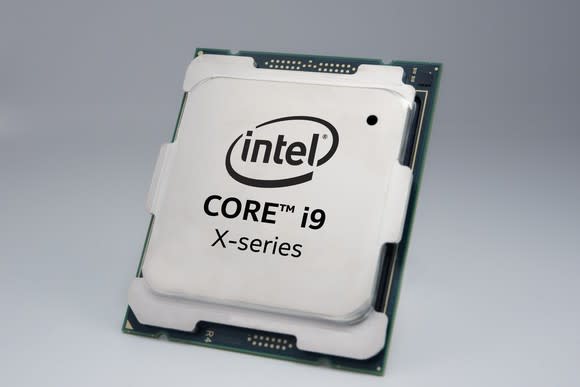Here's What's Next for Intel's High-End Desktop Business
Last year, chip giant Intel (NASDAQ: INTC) introduced a new platform for the high-end desktop (HEDT) market called Basin Falls. The Basin Falls platform incorporated the company's then-new Skylake-X chips (marketed as Core X series processors) -- which were derived from the company's data center-oriented Skylake-SP processors -- as well as a platform controller hub (PCH) marketed as X299.
At a product launch event in New York City on Oct. 8, the company announced an updated set of Core X series processors for the Basin Falls platform/X299 PCH. These chips run at higher frequencies than their predecessors and the company has made some modifications to the lineup, such as eliminating the four- and six-core parts, making sure all of the models have the full 44 lanes of PCI Express connectivity (the six- and eight-core parts in the lineup had some lanes disabled and the four-core parts only had 16 lanes to begin with), and offering a slightly cheaper variant of its 10-core model -- known as the Core i9-9820X -- in addition to a direct price replacement for last year's Core i9-7900X, known as the Core i9-9900X.

Image source: Intel.
Reviews of the highest-end model in the new lineup -- the Core i9-9980XE -- went up on Nov. 13, 2018, although the chips don't appear to be available from online retailers yet.
In this column, I'd like to go over what Intel seems to have planned for the follow-on to these newly announced Core X series models and when we should expect to see them.
Cascade Lake-X comes next
According to an Intel product road map that was leaked by WCCFTech back in August, the company plans to launch the successor to the recently announced Core X-series parts (referred to as "Basin Falls Refresh" in the road map) late in the second quarter of 2019.
That upcoming platform is referred to as Glacier Falls.
The road map doesn't give too many details about Glacier Falls other than the launch timing as well as the fact that the platform will use the company's upcoming Cascade Lake-X processors (the road map indicates that the parts that Intel announced back in October are "Skylake-X" -- same as the ones that Intel launched back in 2017).
Intel hasn't said anything about Cascade Lake-X for the HEDT segment, but on the company's most recent earnings call, CFO and interim CEO Bob Swan went over some of the big-picture improvements that Cascade Lake brings over its predecessor in the data center.
"Cascade Lake introduced hardware-based side channel mitigation, Intel DL Boost with 11x inference speed-up, and a revolutionary new technology, Optane DC Persistent Memory," Swan said.
Later on the call, Intel Chief Engineering Officer Murthy Renduchintala also said that Cascade Lake would deliver "continued generation-over-generation CPU improvements."
For the HEDT segment, I doubt that the Intel DL Boost technology (a technology that Intel says will "speed deep learning inference workloads") will be a big selling point. Additionally, it's not clear if the company will add Optane DC Persistent Memory support to the Glacier Falls HEDT platform. The main improvements, I'd expect, will be the "hardware-based side channel mitigation" that Swan mentioned, as well as further frequency increases from what the current Core X series chips offer.
And, finally, the Glacier Falls platform should introduce a new PCH, which Intel itself seemed to refer to as "X399" earlier this year. I wouldn't be surprised if X399 were simply a repurposed version of the Z390 PCH that Intel currently offers in the mainstream desktop segment (X299 looks like a repurposed version of the Z270 mainstream desktop PCH). Z390 added features such as integrated Wi-Fi, as well as native support for USB 3.1 Gen 2.
More From The Motley Fool
Ashraf Eassa has no position in any of the stocks mentioned. The Motley Fool has no position in any of the stocks mentioned. The Motley Fool has a disclosure policy.
